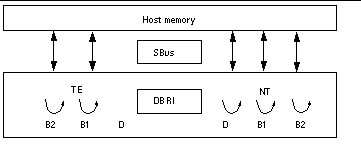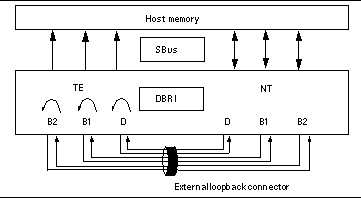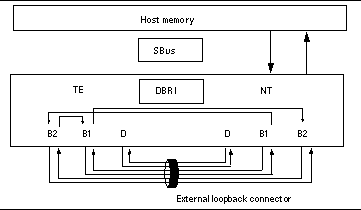Chapter 32 Dual Basic Rate ISDN (DBRI) Chip (isdntest)
isdntest verifies the functionality of the ISDN portion of the Dual Basic Rate ISDN (DBRI) chip.
isdntest Subtests
isdntest is actually a set of several subtests. Three main channels exist within an ISDN: D, B1 and B2. Each channel runs as an independent thread. In each of the following subtests (unless otherwise indicated), the settings are as follows:
Table 32-1 isdntest Channel Settings|
Channel |
Data Mode |
Packet Size |
Packet Count |
|---|---|---|---|
|
D |
Basic Rate HDLC |
256 bytes |
10 packets |
|
B1 |
56-kbps HDLC |
1024 bytes |
10 packets |
|
B2 |
64-kbps HDLC |
1024 bytes |
10 packets |
Table 32-2 isdntest Subtests
|
isdntest Subtests |
Description |
|---|---|
|
Local Loopback test |
The local loopback test checks the initial activation state of the Network Termination (NT) and Terminal Equipment (TE) interfaces to make sure they are deactivated. The test then activates each interface using the "force activation" capability of DBRI. Each interface is put into local loopback mode. Data residing in host memory is written to each interface, which loops the data back to itself. The data is then read back into host memory and verified. Each channel--D, B1, and B2--is tested (with the exception of the TE D channel, which cannot be tested in local loopback mode). The local loopback test runs internal to the DBRI chip and does not require an NT-to-TE external loopback connector. |
|
Activation/Deactivation test |
The Activation/Deactivation test runs through the Activation/Deactivation sequence for the NT and then the activation sequence for the TE. The T101 and T103 timers are set to five seconds. This subtest requires an NT-to-TE external loopback connector. |
|
Remote Loopback test |
The remote loopback capability is tested next. The TE interface is put into remote loopback mode, and the NT transmits data to the TE on all three channels, D, B1 and B2. The TE loops all data back to the NT and reads a copy of it. Data is then verified. Next, the whole process is repeated with the TE transmitting to the NT, which is placed in remote loopback mode. This subtest requires an NT-to-TE external loopback connector. |
|
Read/Write test |
Next, the Read/Write test is performed on all six ISDN channels: TE D, TE B1, TE B2, NT D, NT B1, and NT B2. The external loopback connector connects each channel on the TE interface to its corresponding channel on the NT. A unique data pattern is used for each path. Packets read are compared against packets written. The test is repeated with the B1 channels placed in 64-kbps HDLC data mode and the B2 channels in 56-kbps HDLC data mode. This subtest requires an NT-to-TE external loopback connector. |
|
Packet Size test |
The next subtest is the Packet Size test. A read/write test, similar to the previous one, is performed with a packet count of 100. Each packet transmitted and received is a unique size, computed randomly. This subtest requires an NT-to-TE external loopback connector. |
|
Data Path test |
The last subtest is the Data Path test. Using the ISDN_SET_CHANNEL ioctl, data is routed through a series of short pipe interconnects within DBRI. This subtest requires an NT-to-TE external loopback connector.
|
Figure 32-1 isdntest Local Loopback Subtest

Figure 32-2 isdntest Remote Loopback Subtest

Figure 32-3 isdntest Read/Write Subtest

Figure 32-4 isdntest Data Path Subtest

isdntest Options
To reach the dialog box below, right-click on the test name in the System Map and select Test Parameter Options. If you do not see this test in the System Map, you might need to expand the collapsed groups, or your system may not include the device appropriate to this test. Refer to the SunVTS User's Guide for more details.
Figure 32-5 isdntest Test Parameter Options Dialog Box
 Table 32-3 isdntest Options
Table 32-3 isdntest Options|
isdntest Options |
Description |
|---|---|
|
Packet Size |
The byte size of the B channel packets. The default size is 1024 bytes for the B channels and 256 for the D channels. The maximum packet size is 8186 bytes for the B channels, and the minimum packet size is 1 byte. The D channel packet size is set to 256, except during the packet size test, when it is set to random values between 1 and 256. |
|
Packet Count |
Number of packets to be transmitted and received for all channels. The default packet count is 10 packets. The maximum packet count is 100 packets. |
isdntest Test Modes
Table 32-4 isdntest Test Modes|
Test Mode |
Supported? |
Description |
|---|---|---|
|
Connection |
No |
Not supported. |
|
Functional (Offline) |
Yes |
Runs the full set of tests. |
isdntest Command-Line Syntax
/opt/SUNWvts/bin/isdntest standard_arguments -o size=packet_size, count=packet_count
Table 32-5 isdntest Command-Line Syntax|
Argument |
Description |
|---|---|
|
size=packet_size |
The byte size of the B channel packets. The B channel default size is 1024 bytes. The D channel default size is 256 bytes. The B channel maximum packet size is 8186 packets. The B channel minimum packet size is 1 packet. The D channel packet size is 256 (except during the packet size test, when it is set to random values between 1 and 256). |
|
count=packet_count |
Number of packets to be transmitted and received for all channels. The default count is 10 packets. The maximum packet count is 100 packets. |
Note -
64-bit tests are located in the sparcv9 subdirectory: /opt/SUNWvts/bin/sparcv9/testname. If a test is not present in this directory, then it may only be available as a 32-bit test. For more information refer to "32-Bit and 64-Bit Tests".
- © 2010, Oracle Corporation and/or its affiliates
